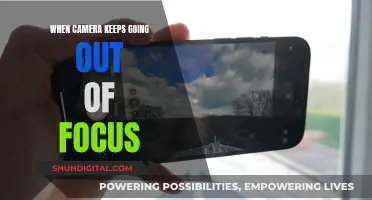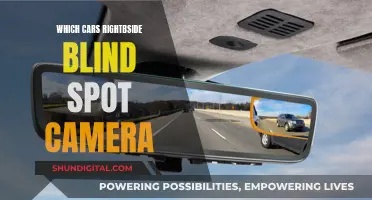
Traffic cameras are an increasingly common feature of roads in the US and worldwide. Proponents of traffic cameras argue that they improve road safety by discouraging speeding and red-light running. However, critics argue that they may cause more accidents by encouraging sudden stops and increasing the risk of rear-end collisions. So, do traffic cameras reduce accidents? The answer is not entirely clear-cut, as studies have shown mixed results. While some studies suggest that traffic cameras can reduce the number of vehicles running red lights and the number of T-bone crashes, others indicate an increase in rear-end collisions at intersections with cameras.
| Characteristics | Values |
|---|---|
| Do traffic cameras reduce accidents? | The data is mixed. Some studies show that traffic cameras reduce the number of vehicles running red lights, while others show that they increase the number of rear-end collisions. |
| Effect on red-light running | Red light safety cameras have been shown to reduce the number of vehicles running red lights. One study in Virginia found a 67% reduction. |
| Effect on accidents | Some studies have shown that red-light cameras increase the number of accidents, particularly rear-end collisions, as drivers try to avoid tickets by stopping abruptly. |
| Effect on injuries | The data is mixed. Some studies show that red-light cameras increase the number of accidents with injuries, while others show a decrease. |
| Effect on fatalities | The data is mixed. One study in Canada found that injuries and fatalities decreased at intersections where police officers increased traditional enforcement. |
What You'll Learn

Red light cameras reduce the number of deadly crashes
Red light cameras are an effective way to reduce the number of deadly crashes. While enforcement by police is the best way to ensure compliance with traffic laws, it is impossible for police to be at every intersection. Red light cameras can fill this void.
An IIHS study found that red light cameras reduced the fatal red-light running crash rate in large cities by 21% and the rate of all types of fatal crashes at signalized intersections by 14%. This amounts to a significant reduction in the number of deadly crashes.
Red light running is a frequent and deadly occurrence. In 2022, 1,149 people were killed in crashes involving red light running in the US. Half of those killed were pedestrians, bicyclists, or people in other vehicles who were hit by red light runners. Red light runners also cause hundreds of deaths and tens of thousands of injuries each year.
Red light cameras have been shown to reduce both red light violations and crashes. A study in Oxnard, California, found that injury crashes at intersections with traffic signals were reduced by 29% after the introduction of red light cameras. Front-into-side collisions, the crash type most closely associated with red light running, declined by 32% overall, and front-into-side crashes involving injuries fell by 68%.
In addition to the direct impact on reducing crashes, red light cameras can also modify driver behavior. The fear of being fined can act as a deterrent and make drivers more cautious when approaching intersections. This can lead to a reduction in the number of angle or "T-bone" accidents, as drivers are more likely to stop even when the light is yellow.
While there may be mixed results in some studies, the overall weight of evidence suggests that red light cameras are an effective tool in reducing deadly crashes and improving road safety.
Privacy Protection: Taping Your Computer Camera
You may want to see also

Cameras don't violate privacy
Red-light safety cameras are an effective way to discourage red-light running, which causes hundreds of deaths and tens of thousands of injuries each year. While enforcement by police is the best way to get people to comply with traffic laws, it is impossible for the police to be at every intersection. Red-light safety cameras can fill this void and reduce the number of collisions and associated injuries and fatalities.
Some people may argue that red-light safety cameras violate privacy. However, it is important to understand that driving is a regulated activity, and individuals who obtain a driver's license are agreeing to abide by certain rules, including obeying traffic signals. Red-light safety cameras are simply a way to catch people who break those rules, similar to traditional enforcement methods. There is no legal or logical reason why drivers should not be observed on the road or have their violations documented.
Furthermore, red-light safety camera programs are designed to improve road safety and modify driver behavior rather than generate revenue. In most states, camera citations are treated as civil offenses, and there are no driver's license points assessed or insurance implications. Additionally, the use of these cameras has been shown to significantly alter driver behavior for the better and reduce the number of right-angle crashes, which tend to be severe.
While some may argue that the use of these cameras violates the principle of innocent until proven guilty, it is important to note that the primary purpose of these cameras is to improve road safety and save lives, not to infringe on the rights of law-abiding citizens. The benefits of reduced accidents and fatalities outweigh the potential drawbacks of these safety measures.
In conclusion, red-light safety cameras do not violate privacy. They are a necessary and effective tool to enforce traffic laws, modify driver behavior, and ultimately save lives. By obtaining a driver's license, individuals implicitly agree to abide by certain rules and regulations, and red-light safety cameras are a fair and reasonable method of ensuring compliance with these rules to create a safer environment for all road users.
Polaroid Land Camera: Battery Power for Instant Photos
You may want to see also

Cameras reduce the number of vehicles running red lights
Red light safety cameras are an effective way to reduce the number of vehicles running red lights. Enforcement is the best way to get people to comply with any law, but it's impossible for police to be at every intersection. Cameras can fill the void.
An IIHS study found that cameras reduced the fatal red light running crash rate of large cities by 21% and the rate of all types of fatal crashes at signalised intersections by 14%. In one study in Virginia, red light cameras reduced the number of total drivers running red lights by 67%.
Red light safety camera programs have proven to reduce the number of red-light-running collisions and their associated injuries and fatalities. While enforcement is the single most effective way to get drivers to comply with red light laws, it is impossible for police to be at every intersection.
Cameras don't violate privacy. Driving is a regulated activity, and people who obtain licenses are agreeing to abide by certain rules. Red light safety cameras are a way to catch people who break those rules, just like traditional enforcement.
Proper signal timing makes intersections safer. Adequate yellow time reduces red light running and leads to fewer crashes.
Transferring Game Boy Camera Photos to Your Computer
You may want to see also

Cameras can increase rear-end crashes
While red light cameras are generally considered an effective way to discourage red light running, there is evidence to suggest that they can also increase the number of rear-end crashes.
Red light safety cameras are designed to reduce the number of vehicles running red lights, and studies have shown that they are effective in this regard. For example, a study in Virginia found that red light cameras reduced the number of drivers running red lights by 67%. However, the installation of these cameras can have contradictory effects on traffic safety.
Some drivers who would have otherwise proceeded through a yellow or red light will now attempt to stop, which can lead to an increase in rear-end accidents. This is because some drivers will accept the higher risk of a non-angle accident, like being rear-ended, rather than incur a fine.
Media outlets have reported on this phenomenon, with several studies finding an increase in collisions at intersections with red light cameras. For example, a report by KATU News in Portland, Oregon, found a 140% increase in rear-end crashes at intersections with red light cameras. Similarly, a report by KCAL TV in Los Angeles found that accidents increased at 20 out of 32 intersections studied, with several intersections tripling their accident rate.
While red light cameras can lead to a reduction in dangerous red-light running crashes, the increase in rear-end crashes should not be overlooked. The overall effect of a camera program on vehicle accidents and injuries depends on the net impact of these two effects, and further studies are needed to fully understand the impact of red light cameras on traffic safety.
Live Mode: iOS Camera's Hidden Feature
You may want to see also

Cameras can reduce front-into-side collisions
Traffic cameras can be an effective way to reduce accidents and make roads safer. While there are conflicting views on their effectiveness, studies have shown that cameras can reduce certain types of accidents and change driver behaviour for the better.
Red-light running is a frequent and dangerous occurrence, resulting in hundreds of deaths and tens of thousands of injuries each year. In 2022, 1,149 people were killed in crashes involving red-light running in the United States. Red-light safety cameras aim to deter this dangerous behaviour and improve road safety.
While enforcement by police is the most effective way to ensure compliance with traffic laws, it is impossible for police to be at every intersection. Traffic cameras can fill this void and act as a form of enforcement. Studies have shown that red-light safety cameras can reduce the number of vehicles running red lights. For instance, a study in Virginia found a 67% reduction in the number of drivers running red lights after the implementation of cameras.
In addition to reducing red-light running, cameras can also improve driver behaviour in other ways. For instance, drivers may become more cautious when approaching intersections, preparing to stop by lifting their foot off the accelerator and covering the brake. This can reduce the likelihood of running a red light and improve overall safety.
Furthermore, cameras can provide valuable data and evidence following an accident. The footage captured by traffic cameras can be reviewed to determine the cause of a collision, identify responsible parties, and aid in insurance claims or legal proceedings. This can help improve road safety by holding drivers accountable for their actions and providing insights for future accident prevention measures.
While there may be concerns about the effectiveness of traffic cameras in reducing all types of accidents, their impact on reducing front-into-side collisions is significant. The implementation of these cameras can be a valuable tool in improving road safety and saving lives, especially at signalized intersections.
Maintain Rear Camera Clarity: Tips for Clean Driving
You may want to see also
Frequently asked questions
There is conflicting evidence on whether traffic cameras reduce accidents. Some studies show that traffic cameras reduce the number of crashes, while others suggest that they increase the number of rear-end collisions as drivers brake more abruptly to avoid fines.
Traffic cameras have been shown to reduce side-impact accidents, such as T-bone collisions, by decreasing the number of vehicles running red lights.
Traffic cameras can increase the number of rear-end collisions as drivers may brake more suddenly to avoid running a red light and receiving a fine.
Yes, traffic cameras can influence driving behaviour. Some drivers may be encouraged to drive more carefully to avoid being caught on camera and receiving a ticket.
Critics argue that traffic cameras are a way for governments to increase revenue through fines. They also raise concerns about government surveillance and the difficulty of contesting tickets issued through traffic cameras.







